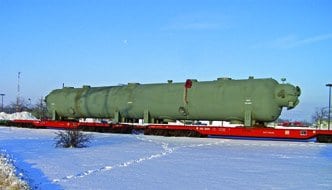Monster moisture separators
Thermal Engineering International (TEI) (USA) Inc. (Santa Fe Springs, Calif.)—a subsidiary of Babcock Power Inc. (Danvers, Mass.)—recently shipped two of the largest pressure vessels in the company’s 90-year history. The pair of huge (13-ft-diameter, 110-ft-long) moisture separator reheaters (MSRs) were designed at corporate headquarters and built in TEI’s factory in Sapulpa, Okla.
The 300-ton MSRs (Figure 3), which were sent to Detroit Edison’s 1,100-MW Fermi 2 Power Plant and were scheduled to be installed last month, will improve the nuclear facility’s reliability and efficiency. As John Austerberry, media spokesman for DTE Energy, Detroit Edison’s parent, explains, "Because the MSRs will be used to dry and reheat the steam passing from the high- to the low-pressure turbine, we expect less erosion of LP turbine blades and an 8-MW boost in plant capacity as well."

3. But it’s a dry heat. This moisture separator reheater is the largest ever designed by Thermal Engineering International (USA) Inc. It’s so big that a special train had to be designed to ship it from Oklahoma to Michigan. Courtesy: Babcock Power Inc.
A bit of history behind TEI’s MSRs: In the early 1970s, many nuclear plants worldwide experienced significant performance problems and frequent failures of the MSRs that original equipment manufacturers supplied with turbine-generators. The units must deal with very complicated and aggressive two-phase flow on both the shell side and tube side.
Identifying the need for a reliable, high-performance MSR, TEI funded a multi-million-dollar R&D program to produce one. Among its objectives were to develop new performance-analysis routines, better ways to test models, and advanced fabrication techniques. According to Abraham Yarden, president of TEI’ s Moisture Separator Reheaters and Advanced Projects division, "The program achieved every one of its goals."
Leveraging the new design and manufacturing expertise, TEI began building new, higher-performing and more-reliable MSRs and retrofitting old ones to meet the higher standards. Over time, operating experience led to cost reductions as well. Yarden says the company isn’t resting on its laurels. "At TEI, we’re continuing our search for more advanced MSR technology with lower lifecycle costs," he says.
Yarden explains that installing a new MSR typically increases nuclear unit output by 3 to 20 MW. TEI has installed more than 400 MSR replacement bundles and moisture separation systems in the U.S., Spain, Belgium, Slovenia, Korea, Brazil, and China.